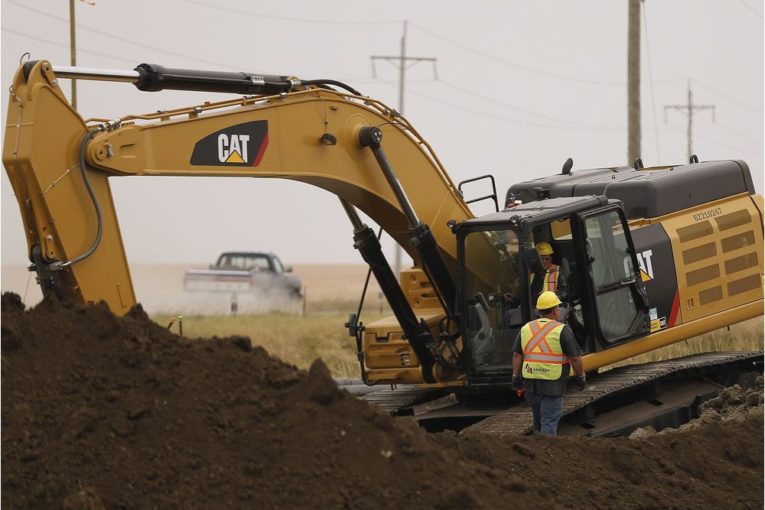
Canadian oil producers didn’t need another reason to a keep a firm fist on their wallets in 2019.
But with the unexpected delay of Enbridge’s Line 3 pipeline project, producers have additional grounds to constrain their capital spending programs in 2019.
Canadian Natural Resources Ltd. said Thursday that it’s disappointed the Line 3 replacement won’t begin operating until the second half of next year — potentially pushing it a year behind initial projections — although it’s confident the development will be built.
In December, the country’s largest petroleum producer unveiled a $3.7-billion capital program for 2019 and held out the possibility of boosting it later in the year.
The pipeline project’s delay makes that less likely, said Canadian Natural president Tim McKay.
“What we did say publicly is with clarity of market access … we would look to increase our budget to $4.4 billion in the latter half,” McKay said in an interview after the company released its fourth-quarter financial results.
“The way we sit today, we’re still at the $3.7 (billion).”
Enbridge’s Line 3 replacement project, which moves oil from Alberta to Wisconsin, suffered a schedule setback last week because of revised permitting timelines from authorities in Minnesota.
The project is expected to add an additional 370,000 barrels per day (bpd) of much-needed oil transportation capacity out of Western Canada.
The timing of the project is critical.
Drilling and exploration in Alberta’s oilpatch has been subdued this year because of pipeline constraints and government-imposed production cuts.
Construction on the Trans Mountain expansion (TMX) project, and TransCanada’s Keystone XL development, remains unclear due to regulatory and legal challenges.
The Alberta government ordered producers to temporarily lower their output by a combined 325,000 barrels per day (bpd) in January to bring storage levels down and the market back into balance.
The policy has worked.
The price differential between benchmark U.S. crude and Western Canadian Select heavy oil has fallen from as high as US$52 a barrel last fall to $11.66 earlier this week.
But it’s also led petroleum producers to stay cautious on their spending plans, with several saying they would re-evaluate them later in the year.
Analyst Jon Morrison of CIBC Capital Markets said Canadian oilpatch spending will largely focus on maintaining existing production, not growing output.
He expects conventional and oilsands capital spending will be down about 20 to 25 per cent this year from 2018 levels.
“We don’t think you’re going to have a massive jump up in capital spending in the back half of the year,” Morrison said.
The Notley government planned to ease the curtailment levels throughout the year, but the idea of ramping the program down was based, in part, on Line 3 providing relief to a clogged system later this year.
On the positive side of the ledger, U.S. oil prices have rebounded above US$56 a barrel and the price discount for Canadian crude has narrowed substantially.
But what will it take for a company to open up its pocketbook this year?
“We need clarity on market access,” said McKay. “Shovels in the ground.”
Canadian Natural isn’t the only company keeping a watchful eye on the situation.
Baytex Energy Corp. CEO Ed LaFehr said Wednesday the company’s spending is on pace to meet its planned cap-ex program of about $550 million.
A decision on $65 million of discretionary spending will to be made in April or May, he said on an analyst’s call.
“We need to see two things — continue to see strong (oil) pricing and, No. 2, we need to see real tangible evidence of additional egress from Western Canada,” LaFehr said.
The latest pipeline twist leaves the industry and political leaders trying to figure out exactly what the transportation landscape will look like in 2019.
There was hope producers would increase their capital budgets in the third quarter of the year, creating more work for the drilling and oilfield services sector after a slow start to the year.
“Clearly, any delay in the increase in take-away capacity is going to have a chilling impact on the amount of production that comes out of Alberta,” said Petroleum Services Association of Canada chief executive Gary Mar.
Some analysts say without Line 3 operating later this year, curtailment levels will likely remain elevated throughout 2019 — and could be pushed into next year.
The change in oilpatch expectations also puts a sharper spotlight on exporting oil out of Alberta by trains.
Scotiabank commodity economist Rory Johnston believes the demand for rail out of Western Canada could top 500,000 to 600,000 bpd by the middle of next year, given the Line 3 setback.
“It was a well timed pressure-release for the oilpatch. The fact it’s being delayed puts a lot more pressure on oil by rail to clear that system,” he said.
In the political realm, the timing of how quickly curtailment ends is also a key matter of discussion.
Premier Rachel Notley said this week the production cuts are still a “short-term strategy” and she doesn’t expect them to be extended into 2020.
“The delay in Line 3 probably does delay the end of the curtailment,” UCP Leader Jason Kenney, who has also backed curtailment, said in an interview this week.
“But I think whoever is in government is going to have to make a factual assessment what to do month by month.”
The province’s hopes of seeing permanent relief to the pipeline problem have been snatched away, yet again, with the latest developments.
It still looks like Line 3 will get built, but the delay is one more reason for the sector to remain tight-fisted in the months ahead.
Chris Varcoe is a Calgary Herald columnist.
You can read more of the news on source
